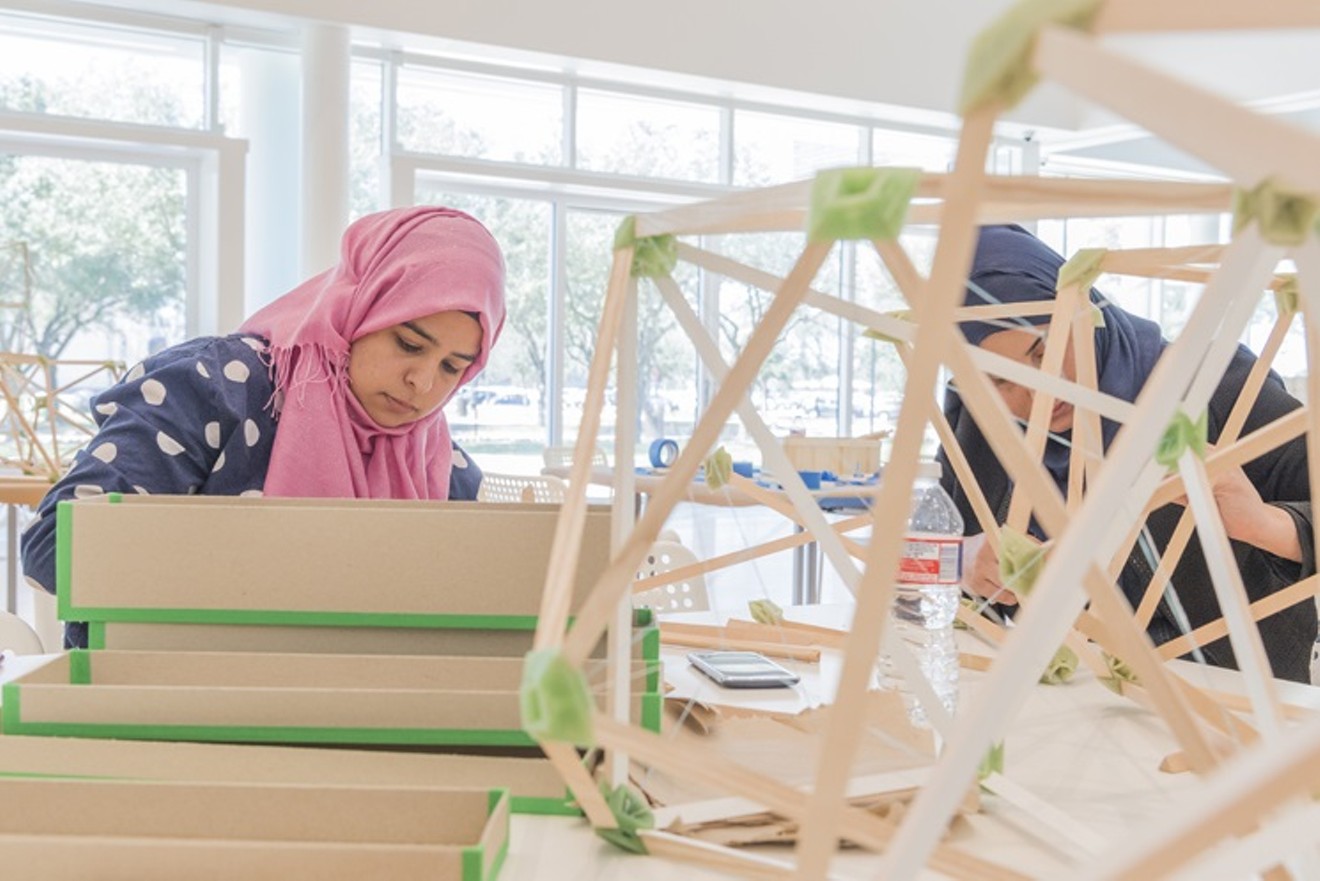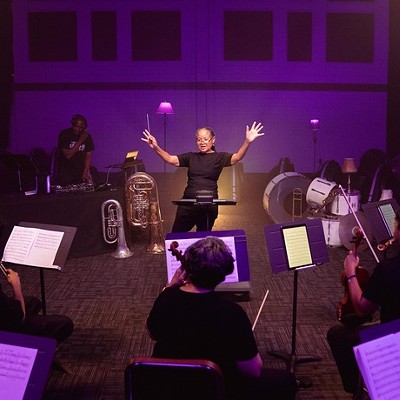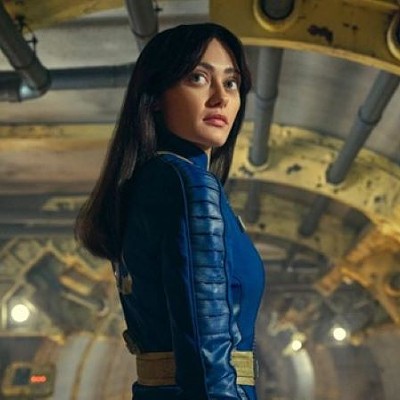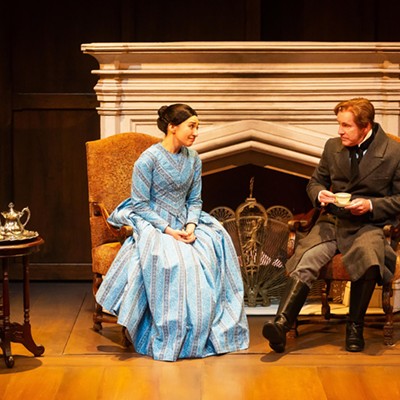Eliasson’s “Green light” is one of the inaugural exhibitions at Rice University’s new collaboration-focused Moody Center, along with “Thomas Struth: Nature and Politics,” “teamLab: Flowers and People, Cannot be Controlled But Live Together” and “Dana Thater: The Starry Messenger.” With the exception of Struth, the opening exhibitions, like the design of the new Moody Center itself, are long on style and short on substance.
“Green light,” first presented in Vienna, was commissioned by Thyssen-Bornemisza Art Contemporary, an art foundation started by the super-rich aristocrat Francesca von Habsburg. The title “Green light” refers to the green LED light of the lamp designed by Eliasson, who intends it as a literal and metaphorical “green light” to welcome refugees. Yes, that is how deep the symbolism goes.
The Moody Center recruited lamp-making participants through Interfaith Ministries of Greater Houston. Three days a week, Monday, Wednesday and Saturday, Interfaith volunteers drive the refugees from far-flung parts of Houston to the Moody Center for the Arts. Arriving at noon, the participants receive lunch and then work making lamps for two and a half hours. Once a week, after work hours, Interfaith volunteers teach an ESL class to the whole group, while other volunteers provide help with résumés. Additional activities have included a photography class, a Rice baseball game and a trip to a Plant It Forward urban farm — the organization helps refugees start their own urban farm businesses.
Each table is a different station in the lamp-manufacturing process. The refugees have been working for a couple of months now, and these people work together with a kind of quiet camaraderie. Apparently they have been having a lot of fun in their ESL classes as they all try to learn English.
When I visited, volunteer Sarah Boardman was at a laptop working on participant Mohammed Horo’s résumé while Horo sanded wood. Horo is a talented musician, a Kurd from Aleppo, Syria, who sings and plays the guitar-like buzuq. He is working as a tailor to try to support his wife and five children. Another man at the table from Syria introduced me to his wife, and told me she is looking for work cleaning or cooking. Even with limited English skills, the participants are friendly and earnest as they try to answer questions or show what they are doing. These people signed up for this project because they want to connect with their new communities.
The finished lamps are faceted wooden frameworks with a network of string and a green light inside. Stretching the (recycled) plastic string inside the lamp is, according to the people working, the most complicated part. The lamps can be grouped into larger geometric forms. They sell for $350 apiece and proceeds go to Interfaith Ministries of Greater Houston, a truly worthy organization. About 12 lamps have sold so far; there are many more available.
The Moody declined to tell me how much the refugees are being paid. But Interfaith Ministries was matter-of-fact about the center’s arrangement. According to Elena Korbut, community engagement coordinator for Refugee Services, the refugees work seven and a half hours a week. The Moody keeps track of days or hours missed and those are deducted. The refugees are paid $8 an hour. That is 75 cents over minimum wage and ends up being $20 for each afternoon worked.
The Moody Center for the Arts cost $30 million. Among the furnishings are Eames conference chairs that cost a couple of grand apiece and, at last report, still had the tags on them. Olafur Eliasson sells work for hundreds of thousands of dollars. Von Habsburg has no shortage of cash.
These refugees manufacture the artwork at close to minimum wage while Eliasson uses their status to make his project Topical! and Interesting! Their histories add cachet to the show.
Houstonians interested in helping refugees can contact Interfaith Ministries of Greater Houston to volunteer or donate — the organization needs everything, from cash to household goods. You can also hire refugees through Interfaith. If you want to employ or help these refugees in particular, their last workday at the Moody is Saturday afternoon, May 6.Nobody likes to work in a fishbowl; staff offices have the same issue.
tweet this
Dana Thater’s “The Starry Messenger,” 2014, will be on view through February 18, 2018. Which would be great if you could actually see it. The nine-panel monitor wall presents video of the Milky Way shot at Los Angeles’s Griffith Observatory. The video wall is opposite one of the many vaunted window walls in the Moody Art Center, and it’s almost impossible to see the video. I don’t know that we are missing much; as far as I can tell, Thater just recorded what the observatory projects in its planetarium. It might, however, be stunning in a darkened, enclosed gallery that could let a viewer imagine the spectacular vastness of space.
Windows and light are lovely, but they can make showing art and other functions problematic. The multitude of window walls make the building and classrooms so loud, professors have had to stop class until groups move from the lobby. The windows of the “makerspace” where people will be using machinery, which can fling objects, seem pretty foolhardy. The window walls on the visiting-artist studio have already been covered by current artist-in-residence Mona Hatoum. Nobody likes to work in a fishbowl. Staff offices have the same issue.
To create the darkened room needed for teamLab’s video installation Flowers and People, Cannot be Controlled But Live Together, which runs through August 13, a room had to be built within a room. The walls are covered with dark, velvety fabric and the floor is covered with dense, dark carpeting that makes the space feel quiet and cozy. teamLab are billed as “operating at the frontier of art and technology.” Which is as pretentious as the idiosyncratic capitalization of this Tokyo-based collective’s name. The room is filled with projections of small, pastel-hued flowers that cluster, lose their petals or disintegrate in response to the viewer’s presence. It seems as if it ought to be amazing, but the result is much more decorative than transcendent and it’s basically a good space for student selfies and Instagramming.
“Thomas Struth: Nature and Politics” runs through May 29 and has some great work. In the series on view, Struth uses a large-format 8x10 camera to capture images of complex technology, photographing places like NASA or the Max Planck Institute of Plasma Physics in Germany as a kind of man-made landscape.
His massive photograph Space Shuttle 1, Kennedy Space Center, Cape Canaveral, 2008 is about six feet high and 12 feet wide. It shows the looming underside of the space shuttle, its belly covered with a grid of insulating tiles to protect the shuttle during re-entry. There are around 24,000 of them, six by six inches each. Their gray surface makes them look like a Roman road, and you think about how such complex technology used this ancient idea of paving. Struth’s photograph shows the mobile scaffolding used to check and mark damaged tiles. No human beings are visible, which somehow emphasizes how few of us actually understand this thing that has been created.
Stellarator Wendelstein 7-X Detail, Max Planck IPP, Greifswald, 2009, is another massive photograph showing a technological bird’s nest of pipe and brackets and wires and clamps. You realize this tangle of mechanics is the direct result of its function. A lone glove rests on top of the mass, like the wheeled scaffolding in the space shuttle photo, a relic of human interaction.
A smaller-scale photograph, Tokamak Asdex Upgrade Periphery Max Planck IPP, Garching, 2009, is an expressionist tangle of coils, loops and bundles of multicolored wires. They look like the veins and arteries of some frightening cyborg.
The exhibition is too large for the space, the only conventional gallery space in the building. Multiple pricey temporary walls were built for additional hanging space. They are set at angles to each other and the effect is of a densely overhung show. Maybe that claustrophobia is intentional — the mass of imagery in the space mimicking the masses of forms in the photograph. But in the end, it is just really difficult to see and experience Struth’s work when it’s so jammed in.
We’ll see how the gallery works for future exhibitions, but the lack of a crawl space in the ceiling means that hanging things from above is not going to be an option. Other functions have similar problems with the space; in addition to the loud classrooms, the “studio” spaces don’t have storage space for work, and the black box theater has nowhere to build or store sets. No department is housed at the Moody Center, which is presented as simply a 50,000-square-foot space for collaboration but so far feels like a rental hall in which occupants are allowed a short period of usage and then have to clean up and clear.
Green light — An artistic workshop
Dana Thater: The Starry Messenger
teamLab: Flowers and People, Cannot be Controlled But Live Together
Thomas Struth: Nature and Politics
All exhibitions are on view at the Moody Center for the Arts, Rice University, Campus Entrance 8 at the intersection of University and Stockton. Hours: Tuesday through Saturday 10 a.m. to 5 p.m. For more information, call 713-348-2787.






